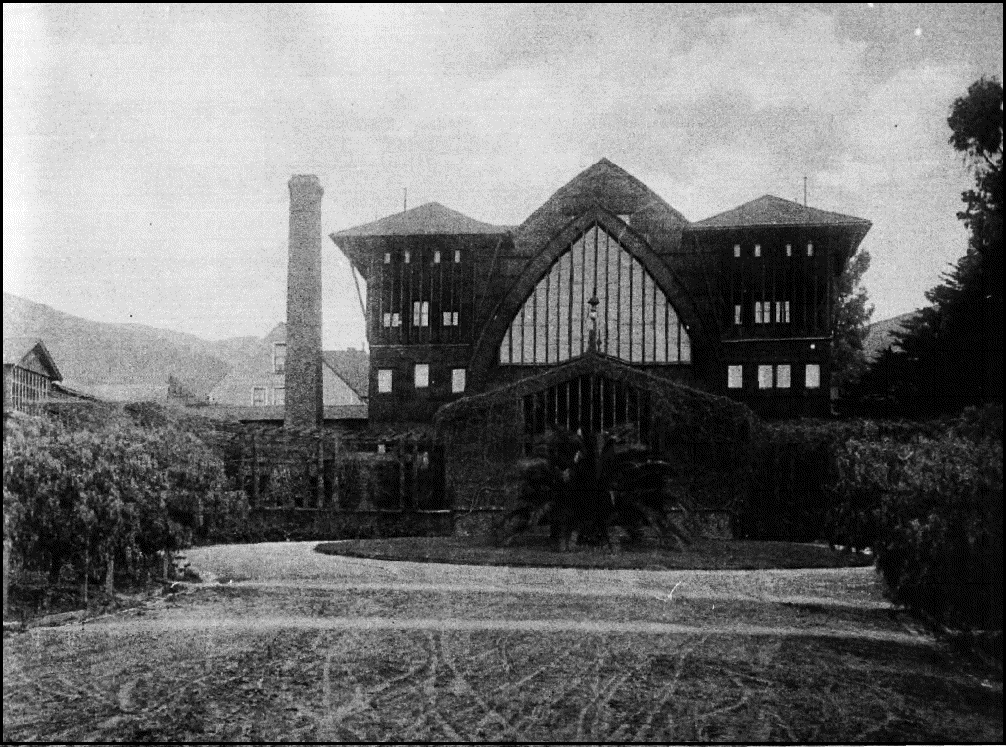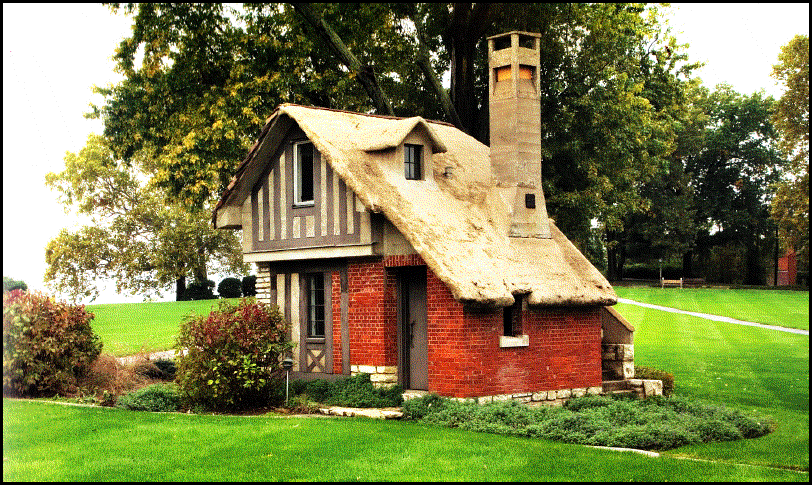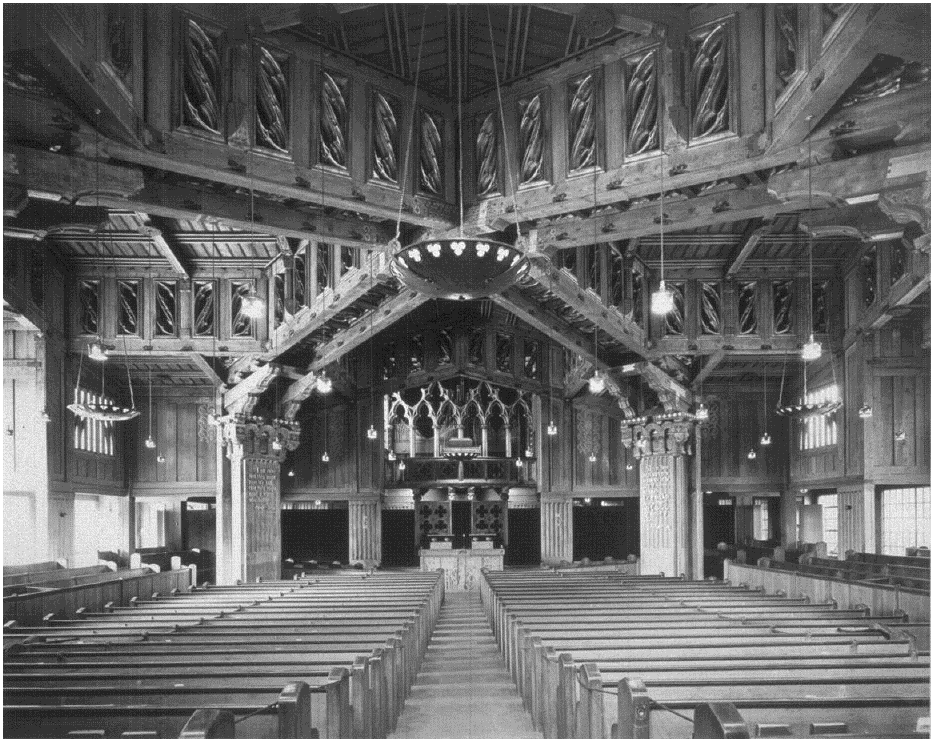
Bernard Maybeck
Architect of Elegance
Mark Anthony Wilson
(Gibbs Smith)

Sometimes I feel like such a dummy. I lived in St. Louis for several years and during all that time I never knew about, never visited Bernard Maybeck's great campus built for Principia School in the 1930s, just north in Elsah, Illinois. There is a stately, New England-inspired chapel, six dormitories along with several other buildings, including Watson Laboratories, the Morey Field House, and Mistake House.Maybeck said he wanted to build an English village, but what he designed was a merry jumble of styles spread about on a huge campus, Gothic mixed with Medieval, touches of Rustic and Craftsman, a dash of Tudor, all edged in slate, shingle, brick and stone in the form of 17th Century Cottages.
Where Maybeck always excelled were the ceilings, which at times can put one in mind of the Alhambra. Most dynamic here is the ceiling of Anderson Hall's living room, "king posts and trusses ... formed out of molded concrete, textured to simulate hand-carved wooden timbers." It soars over the whole like a giant bird.
Maybeck's fireplaces were always massive, and grand, as befits a time when nearby forests were available for pillaging. Atop the pile would be a profusion of pilastered brick chimneys, hipped roofs, and stucco walls filled with half-timbering and gables. It's the kind of architecture that never lets the observer forget who is boss: the structure itself is in charge; the rest of us are but temporary visitors.
My favorite of exterior oddities at Principia is Rackham Court, with gothic windows surrounded by arbitrary chunks of mortar, what was called "oozing mortar." There is the Buck House rainspout, a sinuous supine gargoyle laid out on the roof. Finally, there is Sample House, an "old English thatched-roof cottage." Maybeck used it to test materials and construction methods that were meant to survive the humidity of Missouri. Because many of these experiments failed, what he had dubbed as "Sample House" was renamed "Mistake House" by the workers. The name stuck.

Then, to prove that I am even more of a dolt, there were the two years I lived in Berkeley, California. I never visited the looming Schneider House on Arch Street, the gawky Owens house in Ashmount Avenue, the severe Kellogg House on Linden Avenue. And most appalling, I didn't have the time or the interest (my marriage was falling apart, my schooling at the university was a bust, my night life was a shambles) to spend an hour or so going through the First Church of Christ, Science, on Dwight Way.Wilson compares it to the great Gothic cathedrals of western Europe --- sees it as "one of the world's great houses of worship"... and from the brilliant color photographs shown here, he just may well be right. The double page spread of the auditorium shows a space with the typical transcendent Maybeck ceiling:
One's sight is drawn upwards along the elegant curves of the ornate cross-trusses towards the apex, where the two arcs meet in the center ... These trusses rest on four massive concrete squared pillars, which stand about 40 feet apart. Although the height of the ceiling is only about 30 feet at its peak, Maybeck's creative use of industrial technology wedded to the visual richness of his details creates the impression of a much taller space.
The trusses, called the "Pratt Truss System" is a familiar pattern we see on old railway bridges, and indeed, there is a touch of the industrial in the arches here. But Maybeck threw in a bonanza of colorful rococo tics to make us forget the mechanical, with sea-green and gold and dots and spikeheads and playful snake-like figures among bolts and daubs and arabesques on the windows, even the initials of his wife thrown in for insiders.
Most of us are familiar with Maybeck's Palace of Fine Arts in San Francisco ... the Beaux-Arts world's fair pavilion with its lurid Corinthian columns and Roman entablature and sub-tropical lush plantings, a mish-mash of Greek, Roman, and Renaissance all out of proportion (and pink columns, even). One would have to be a dangerous romantic to find this "architrave and corona of the colonnades" beautiful, but I suppose its very gaudiness will ensure that it has fans through the centuries. Still, I suspect that we are better off across the Bay praying to the strange divine that lives on in Mary Baker Eddy's divine auditorium.
Speaking of divinity: this volume runs 230 pages with more than 300 illustrations, mostly in color. Editor Wilson wanted only to include the still-existing buildings designed by Maybeck, but there are few black-and-white photographs of those structures that have gone in a blaze, one of California seasonal fires that can do urban renewal on whole neighborhoods.
What's worse are the scandalous developers whose ignorance of California architectural artistry can bring a tear to the eye. Los Angeles's Packard showrooms --- built for Earle C. Anthony --- fell on the sword of redevelopment. May the perpetuators of these evils forever dwell in architectural hell, in, say, a lifetime in the third floor of a cheap condominium designed and built by Donald Trump.

--- Edward Dwinelle